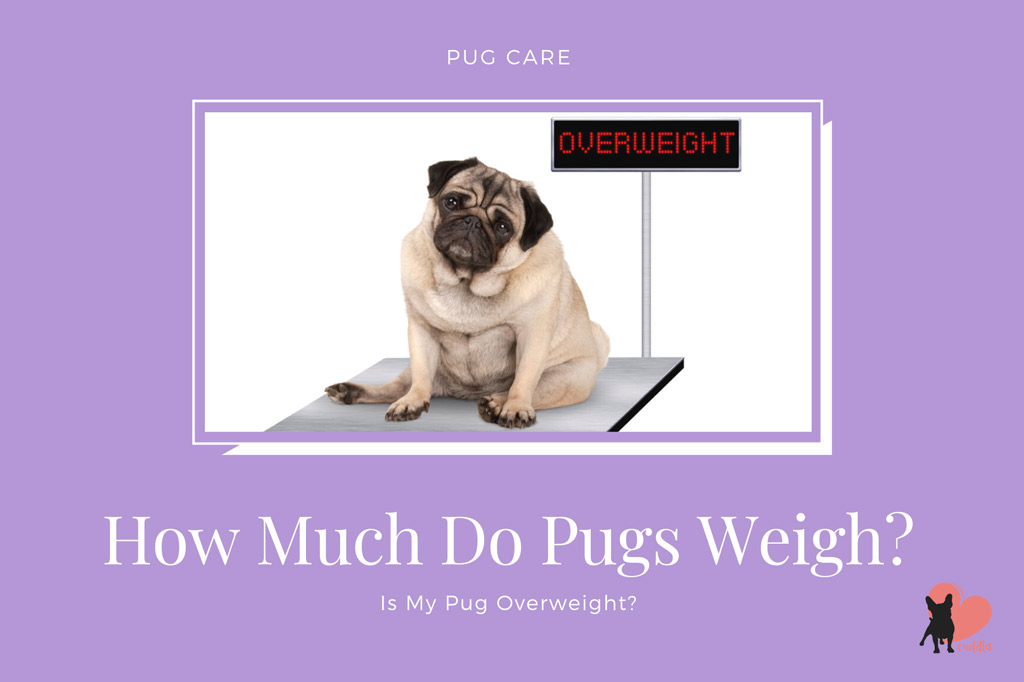
Pugs are very loveable pet dogs that as an owner, you can’t help but want to give your dog all they want. And if there’s one thing pugs (and many dogs) love, it’s food.
Noticing your pug’s weight change is usually a sudden realisation, and since you know your dog being fat or obese is detrimental to health, the question becomes – what is a healthy weight for a pug?
Adult pugs weigh between 6.5 kg (14.3lb) and 8.5kg (17.6lb), both males and females, with their height being between 10 to 13 inches (25-33 cm). Pugs outside of this range could either be underweight or overweight.
But how likely is it for your pug to be overweight? And how can you help your pug lose weight? Read on to discover more, including 8 tips for weight management.
How Much Should Pugs Weigh? – Breed Standards
Mature pugs of both sexes are usually close in height and weight.
When fully grown, pugs are 10 to 13 inches in height (25-33 cm). According to the AKC breed standard, both male and female pugs should ideally weigh between 6.5 kg (14.3lb) and 8.5kg (17.6lb).
| PUG AGE | PUG WEIGHT |
|---|---|
| 8 weeks | 2-4 pounds (0.90-1.81 kg) |
| 6 months | 7-12 pounds (3.17-5.44 kg) |
| 1 year | 13-18 pounds (5.89-8.16 kg) |
Don’t be too alarmed if your pug is outside this range.
Essentially, if your pug is below this range, she could be underweight and if she’s over this range, she could be overweight.
Further down I will explain how you can tell your dog’s body condition i.e., if she’s underweight, on her ideal weight, or overweight.
According to the pug breed standards, a pug’s shape is square, with a compact form and hard muscles. Their body is short and cobby, wide in chest and well ribbed up.
Always check with your vet to get an accurate diagnosis since more athletic pugs will have bigger muscles and will weight more.
However, if your pug starts looking like a big barrel, you should really start getting concerned.
Read also: When Are Pugs Full Grown? [Growth Chart Included].
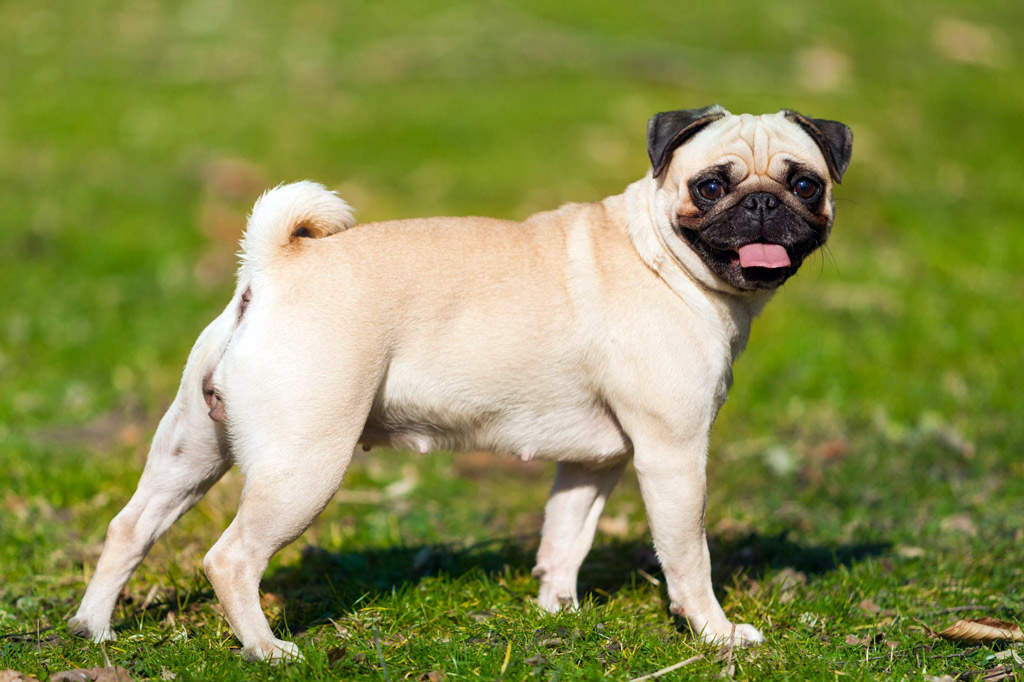
Is My Pug Overweight?
Pugs have a very high potential for weight gain.
They can be greedy eaters and will overeat if they are given the chance. Since pugs gain weight easily, they can quickly become overweight and suffer from obesity.
When the food intake isn’t monitored carefully or the diet is not appropriate, your pug is likely to put on weight. Also, a lack of exercise will promote weight gain.
How to Tell If Your Pug Is Overweight
Subtle changes are hard to spot. You might not notice a couple of extra pounds on your pug when you see her every day!
It’s like kids, you don’t realize how fast they grow until their clothes won’t fit anymore! However, you spot those changes straight away if you go for a couple of weeks without seeing them.
So, if you want to assess your pug’s weight, you can do three things (apart from putting her on a scale):
- A visual evaluation.
- A rib test.
- A body condition score.
Visual Evaluation
Although looks can be deceiving, you should look at your pug’s body condition with a critical eye and ask yourself the following questions:
- Are rolls of fat visible in her mid-section?
- Does it look like her neck and waist have disappeared?
- Does she look bloated or stuffed?
If the answer to any of these questions is yes, then your pug is overweight.
Take it a step further and do the rib test to be sure.
Rib Test
A good way to know if your dog is overweight or not is the rib test. Run your hands around her flanks and abdomen for an assessment:
- If you feel the ribs, your pug’s weight is average – you should be able to feel them without pressing too hard.
- If you don’t feel the ribs, your pug is overweight
- If you see your pug’s ribs, your dog is too skinny.
After assessing your pug and realize that your pug is overweight, you’ll learn further down what you can do at home to help your pooch and when to consult with your vet.
Body Condition Score
What is the shape of your pug?
Have a look at this pug body condition score chart to assess both male and female pugs:
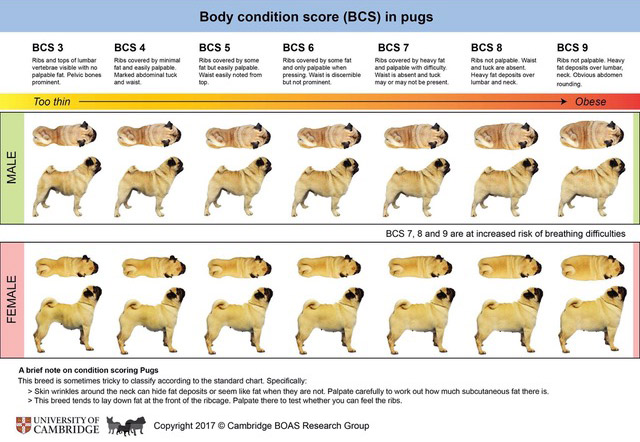
Pug Obesity
Canine obesity is one of the fastest-growing health concerns affecting dogs today. According to a survey by the Association for Pet Obesity Prevention (APOP), 56% of dogs in the US are overweight.
Symptoms of Obesity in Pugs
Here are some common symptoms or signs that a pug is overweight (source):
- Weight gain – your pug’s weight is over the average for the breed and age.
- Excess body fat – not being able to feel the rib cage, skin rolls, thick fatty neck, etc.
- Inability (or unwillingness) to exercise (including going for walks).
- High body condition score – when looking at your dog from the side, the waist isn’t obvious or/and her shape not being wider at the chest and thinner at the abdomen (see image above in Body condition score).
Factors that Contribute to Your Pug’s Obesity
Why do pugs become overweight?
Several factors make obesity more likely in pugs:
- Breed: Certain breeds (like the pug) have a higher risk.
- Age: The risk increases with age due to the gradual decrease in metabolism. If older dogs continue to eat the same quantity but are more likely to be less active, they can easily put on weight.
- Neuter status: Neutered dogs are more at risk. When dogs go through this procedure, their metabolic rate lowers and the energy that they require decreases by about a third. So, they can put on weight easily if their diet and exercise are not adjusted accordingly.
- Diet: If your pug’s diet it’s not balanced and the quantity is not fixed, this can lead to weight gain problems. In fact, regular treats contribute to unhealthy weight imbalances.
- Activity level (exercise): Your pug’s physical activity plays an important part in maintaining a healthy weight. Exercise keeps your dog fit and agile. Plus, it also helps to prevent digestive problems. If your dog doesn’t burn calories, she’s likely to become obese.
- Personality: Some dogs may only eat what they need to, while others will eat everything you give them and will still look for more (pugs seem to fall in these part of the spectrum). Pugs have a good appetite and most are not that picky about food. Also, they often gulp down their food, especially when fed from a food bowl.
- Social aspects: Pugs that live with other dogs or cats may tend to eat more, or eat more quickly, than those in a single dog household. On the other hand, dogs that don’t live with other pets tend to be spoilt more with treats. So either way, watch out for how much food your pug eats daily.
- Medical condition: Some serious underlying diseases can lead to excessive hunger and lead to weight gain, these include:
- Hyperadrenocorticism (Cushing’s disease).
- Diabetes.
- Hyperthyroidism.
- Exocrine pancreatic insufficiency (EPI).
Apart from biologically inappropriate diets and underlying diseases, there can be a variety of causes for constant hunger in dogs, including:
- Canine biology.
- Memories of food scarcity.
- Learned behaviour.

Why Being Overweight is Detrimental to Your Pug
Being overweight can have a large impact on a pug’s life, overall health and even cuts their life expectancy by years.
Excess body weight is a severe hazard for pugs since obesity can lead to (source):
- A shorter lifespan: Dogs fed a healthy and controlled diet during their lifetime live much longer lives than those that are overweight. A study showed that obese dogs live 1.8 years less than their lean counterparts.
- Breathing problems: The respiratory difficulties that occur in brachycephalic breeds like pugs, will only worsen when overweight. With extra fat around the neck, chest and face, pugs will struggle even more to breathe.
- Major health problems: Obese pugs have an increased risk of many health problems. Canine obesity is associated with several major health issues, including diabetes, heart disease and arthritis.
- Osteoarthritis or joint problems: Excessive body weight puts stress on joints and can affect a dog’s risk of ligament rupture and arthritis. Likewise, the inflammatory state obesity causes in the body also contribute to poor joint health. After developing these conditions, it may be painful for a dog to move and exercise, making it more difficult for them to lose weight. It causes a lack of tolerance for exercise.
- Heat intolerance: Overweight pugs are far more likely to suffer (or even die) from heatstroke than dogs of a healthy weight.
- Skin disease: Nonallergic skin diseases increase in dogs with excess weight. Pugs already have skin issues due to their skin folds (which harbour bacteria if not cleaned). If overweight, skin and coat problems only get worse.
An overweight pug is much more likely to develop health problems. So, consider insuring your dog as soon as you can – from day 1, before any signs of illness begin.
This will ensure that you have all the support you need to care for your pug throughout their lifetime. Petplan pet insurance covers all hereditary and chronic conditions as standard.
The good news is that reducing your pug’s weight can reverse most of these consequences and risks. Continue reading to find out what I did to reduce Tootsie’s weight (a 7-year-old female pug).
A pooch with a healthy weight and who is in shape is more likely to enjoy a long and happy life, which is rewarding for both you and your doggy! 🙂
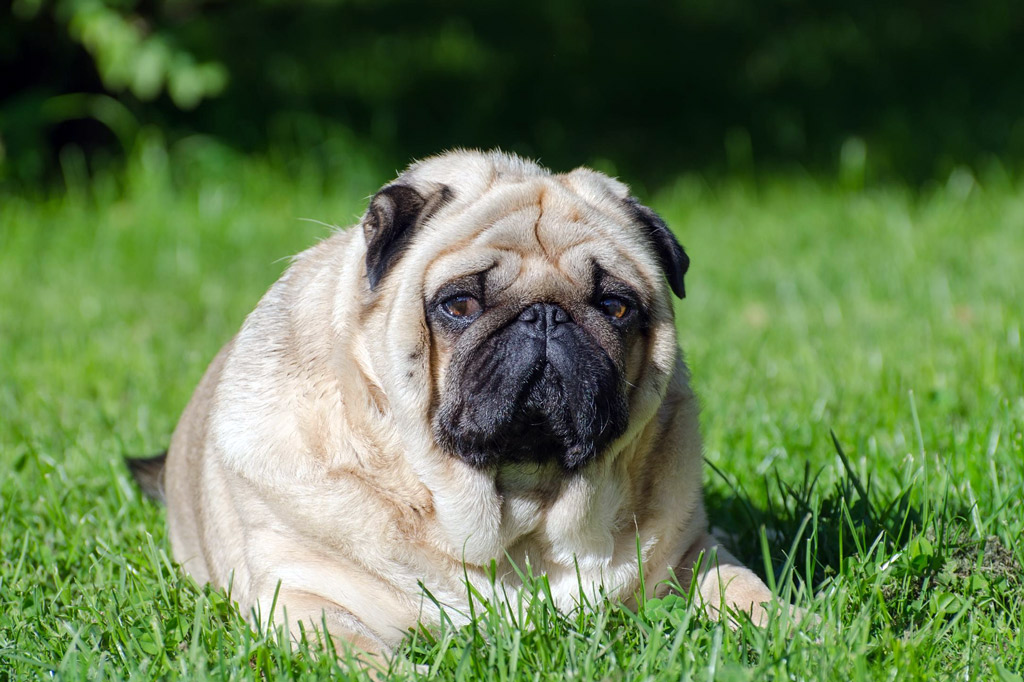
Pug Weight Management Steps
Tootsie, our foster pug, was overweight when we got her. Whilst she stayed with us, we eased her into a fitness plan. I was astonished at how she adapted to us – her foster parents, her new routine, recovered from being spayed and also lost some weight!
By the time she got adopted, she has lost some bodyfat (still needed to lose a bit more) and was getting used to walking daily (not sure if she used to go for walks before because she got tired easily).
So, you might be wondering… How can I help my pug to lose weight?
After you have ruled out that your pug‘s extra fat has nothing to do with a medical condition (like Hyperthyroidism), there are a few things you can put into practice.
Here’s how to get your pug to lose weight:
#1 – Avoid Inappropriate Dog Food
Processed dog food (aka kibble) containing grains, starches and added fibre can create malnourishment at the cellular level, leaving your dog feeling hungry.
Your dog’s biological requirement for fibre and carbs (starch) is little, which means when fibre replaces protein in the diet, your pug can end up obsessively searching for more amino acids.
In addition, too much fibre can block the absorption of necessary nutrients into the small intestine. This can create a barrier preventing the gastrointestinal tract from absorbing antioxidants, vitamins and trace minerals.
While your furry friend will feel full only temporarily, she will remain undernourished at the all-important cellular level.
This can result in feelings of constant hunger, a sign that your carnivorous dog isn’t getting enough protein to adequately sustain his biology.
Are pugs always hungry?
Your pug should feel satisfied if she eats a balanced species-appropriate diet. In summary, avoid too much fibre and cut down the carbs to improve her diet and reduce hunger.
Read also: Dog Nutrition: The Ultimate Guide to a Balanced Diet and High-Value Dog Treats: What Types of Reward to Give.
#2 – Ignore Begging Behaviour
Given how much pugs are known to “beg” when there’s food around, you might wonder – are pugs obsessed with food?
Memories of food scarcity and learned behaviours (like gulping food down and begging) can make it look like your pug is obsessed with food.
Dogs who learn that begging and other food-seeking activities get results will continue the behaviour until it is no longer rewarded. That’s why you must master the art of self-control and learn to ignore begging in order to avoid overfeeding your doggy.
Also, don’t feed your pug table scraps since they can give your pooch digestive issues, including gas.
Dogs metabolize foods differently from humans. That’s why it’s good to know which foods are safe for your pug.
You can try to:
- Feed your pug more frequent meals, i.e. divide the total daily calorie intake into more portions.
- Add water and veggies to her food bowl to increase the volume but not the calories.
- Distract your dog with games or take her for a walk.

#3 – Slow Down Speed Eaters
Does your pug gulp down everything you give her?
Especially for dogs that may have experienced and suffered from malnourishment and food deprivation in the past, they will tend to eat quicker than dogs with no trauma. The main reason is the fear of not getting more food later on.
However, that’s not the only scenario.
Some dogs just love food and cannot help themselves. Tootsie would go nuts when she saw food and would eat (actually swallow is more appropriate!) as quickly as possible, which is not a good habit.
Speed eaters that are also a brachycephalic breed (like pugs and Boston Terriers) can get an upset stomach and fart a lot as a result. The swallowing of air plus the breed’s trait (brachycephalic) will cause more farting.
If your pug swallows whatever you give her, there are a few things you can try:
- Divide your pug’s meals into several portions (i.e., don’t feed her all at once).
- Use a rubber dispenser toy like a Kong to slow the feeding process.
- A Lickimat Slow Feeder for smoothies, apple sauce and other pasty meals. Also helps to keep your pooch focused when you are grooming her! It’s a 2-in-1 for me!
- Raised slow feeder bowl (features a raised centre to make swallowing large amounts of food impossible for your dog) – helped Tootsie, the pug in my about profile photo. 🙂
#4 – Follow a Balanced Diet
Regardless of your pug’s weight, your dog always needs the right nutrition.
So feed your pooch a nutritionally balanced, species-appropriate diet. This means foods that are high in animal protein and moisture, with low or no grain content.
Regardless of the type of food you feed your pug, you want to stay away from these ingredients:
- Soy.
- Corn.
- Grains.
- Legumes: lentils, chickpeas and beans.
- Potatoes.
- Rice.
- Peas.
Avoiding (or at least cutting down) these will improve your dog’s diet and reduce gassiness too. Only 6% of your dog’s daily calories should come from carbohydrates, including healthy vegetables and fruits.
If your pug follows this type of diet, it’s unlikely that her food-seeking behaviour is related to malnourishment.
In that case, your furry friend may have an underlying condition that is interfering with her body’s ability to properly digest nutrients from his diet.
Read also: Dog Nutrition: The Ultimate Guide to a Balanced Diet.
#5 – Calculate the Food Quantity
It’s essential to know how much on average pugs should eat. This is probably the most overlooked step in weight loss success.
Also, it’s important to monitor your puppy’s weight whilst growing up. It’s a great way to know that you are feeding the right quantity.
Avoid inconsistent portioning; after calculating the daily food intake, you can practice portion control. The food quantity per day should include both meals and treats quantity.
Insider Tip: Treats should consist of no more than 10% of the daily food intake.
So, how much food does your pug need to reach her ideal body weight?
| WEIGHT | FOOD QUANTITY PER DAY |
|---|---|
| 5 to 10 lb | 1/2 to 1 cup |
| 10 to 15 lb | 1 to 1 1/2 |
| 15 to 20 lb | 1 1/2 to 1 2/3 |
P.S. You can get a measuring cup set on Amazon to make your life a bit easier as your pug’s food needs may change throughout her life. For me, it’s the easiest way to calculate each meal. 🙂
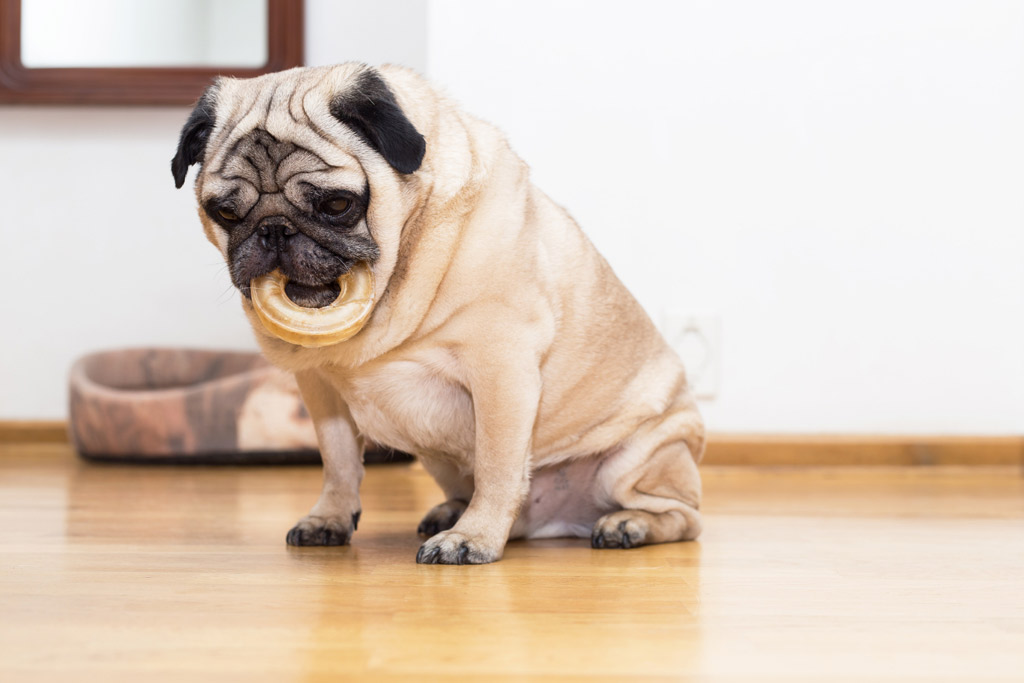
#6 – Follow a Feeding Schedule
Avoid free feeding. Setting feeding times will help you have a routine and control exactly how much your pug is eating.
From 8 weeks onwards, you will start to gradually reduce the number of times you feed your pup until you settle on 2 meals when she’s 1 year old.
| AGE | NUMBER OF MEALS |
|---|---|
| 8 weeks | 5 meals |
| 3 months | 4 meals |
| 6 months | 3 meals |
| 12 months | 2 meals |
Traditionally, the recommendation is that adult dogs (from 12 months and older) should eat just once a day.
However, you can feed your adult pug twice a day: breakfast and dinner. Giving two meals a day may make it easier for the dog to digest the food (avoiding getting bloated) and helps control hunger.
If your pug is a senior, you can continue to feed her twice a day (breakfast and dinner) to encourage easier digestion.
#7 – Keep Track of Weight Changes
You can weigh your pug at home with a scale. Otherwise, you can take her to your vet to measure her weight and check on her progress.
Monitor your pug’s weight loss and increase or decrease her calorie intake to make sure you are hitting the target rate.
How fast does a pug lose weight?
Ideally, your pug will be losing between 0.5 – 2.0% of their starting body weight per week. At first, they may lose weight at a faster rate because of a loss of water weight. So, if you see your dog has lost more than 2% per week early on, there’s no need to adjust the daily food serving.
#8 – Make Daily Exercise a Must
Finally, exercise!
Remember that daily physical fitness is a must for your pug’s health. Just think of daily walks and some playtime like a fetch game.
Given the opportunity, your pug will happily spend much of the day snuggling on the sofa next to you.
However, pugs are a playful breed and can even excel in dog sports like agility!
So, don’t let their “chill” persona deter you from daily exercise. The breed’s fondness for eating and being a couch potato mode will only have detrimental results on their health!
Insider Tip: Stay consistent during and after your pug has lost weight!
If you want to know more about how much exercise your dog needs and how often, visit our How often should I walk my dog blog post. And, if you don’t have much time for walking your dog, use my favourite dog care option.
Read also: Dog Exercise and Stimulation: A Complete Guide.
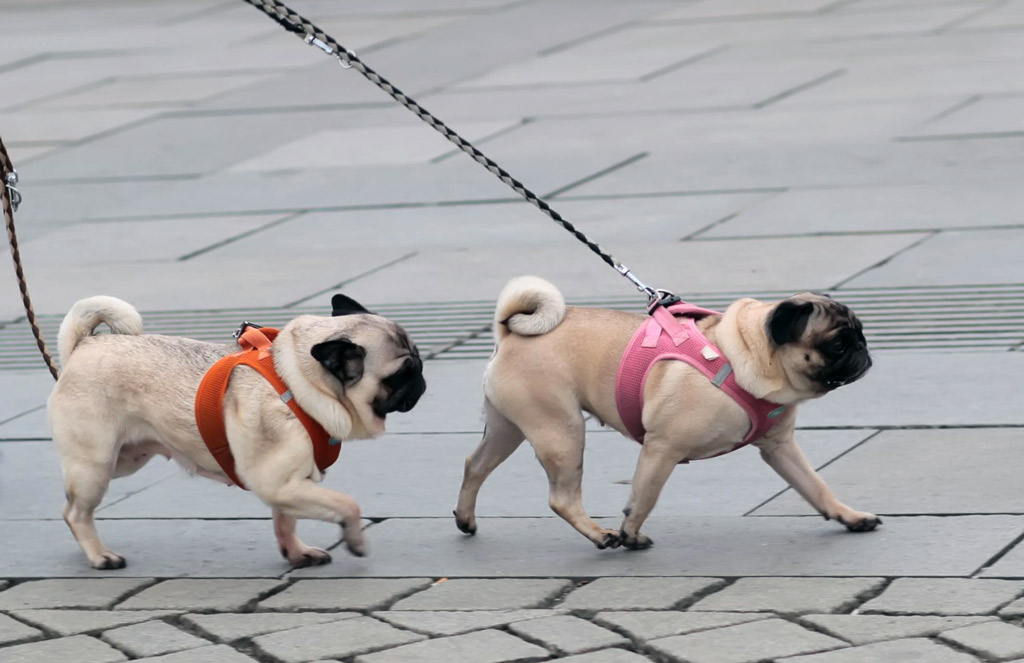

What food is good to help with my pug he doesn’t like kibble. I am feeding him Tom and sawyer
Thanks
Hi Breanne,
I assume the help you’re seeking is related to weight and health? Tom and Sawyer are a reputable brand from what I know.